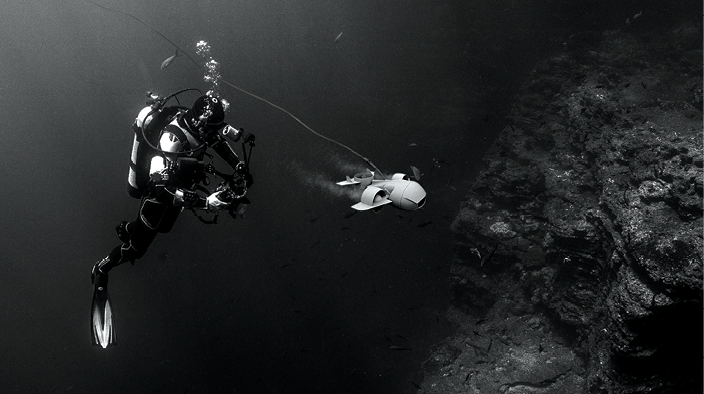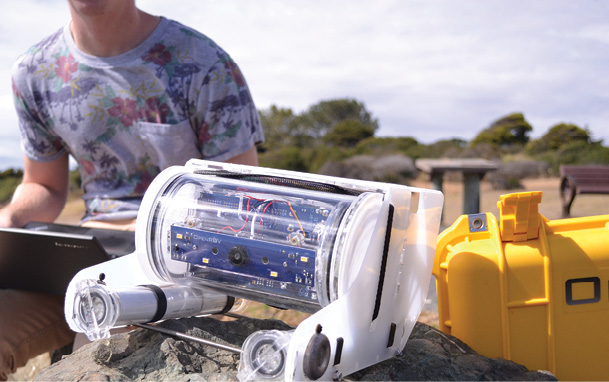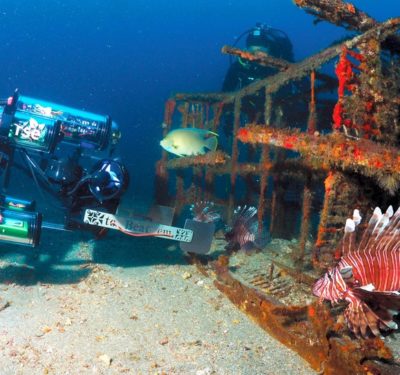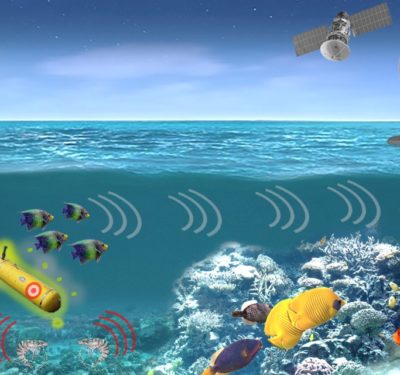
Courtesy OpenROV
Hidden gold, a drowned child and sunken horse drawn carriages: the stuff of local legend—and the catalyzing mysteries that helped launch a new class of underwater drones.
This new category of remotely operated vehicle (ROV) is highly portable and intuitive to operate. What really sets them apart, however, is their price. Most of those described here—which will all be available by this summer if they aren’t already being shipped—sell for $1,200 or less. At those prices, and with the flexibility being built into their designs, they are poised to shift the flow of innovation to the ‘smalls,’ likely kicking off a host of industrial applications down the road.
They are “the hot ticket these days,” said Philip McGillivary, who tracks technology as the science liaison for the U.S. Coast Guard Pacific Area/Dept. Homeland Security.
Series 2
“It all started with a story of buried treasure,” said Eric Stackpole, a co-founder of OpenROV, which is known for its make-your-own ROV kits. A student working at NASA-Ames at the time, Stackpole had begun building his own ROVs out of frustration.
“When we’re working on a satellite, it’s probably 15 years before a mission actually launches, if it ever launches, and we don’t have control of it—you need a rocket ship to get to space,” he told Inside Unmanned Systems. “I realized the ocean is this dark, mysterious place where there are creatures we’ve never seen before…and all you need is a shoreline and some curiosity.”
That desire for personal exploration was sharply refocused, however, when a friend told him the story of a cache of stolen gold.
“During the gold mining days of California,” Stackpole said, “there was this gold heist and allegedly 100 pounds of gold was hidden in this reportedly bottomless, water-filled pit in the back of a cave that no one had been able to get to the bottom of. So that kind of gave me a reason to build this robot.”
Stackpole took his ROV and, with his soon-to-be cofounder David Lane, found the cave and the pool. “We didn’t even know if the story was true. Sure enough we found the cave. In the back of it, just like reported in the story, we found this kind of perfectly circular, six-footish diameter hole going straight down.”
Unfortunately, the ROV didn’t make it to the bottom.
“This is the early days and we had a lot of problems with the robot,” Stackpole said. “We had a lot to figure out.”
The publicity surrounding the attempt, however, attracted people interested in ROVs and that group coalesced to support a series of improved iterations of the device. After they dispatched the technological gremlins Stackpole and Lane launched a Kickstarter campaign offering do-it-yourself kits containing everything necessary to build an operational ROV.
“The kit is what we’ve been selling since that first Kickstarter project in 2012 and we’ve sold more than 3,000 of them. In fact, I think that would make us the largest volume ROV manufacturer in the world,” Stackpole said.
Those kits, now on version 8 of the Series 2 design, have fueled the growth of a worldwide community. Fostered by Lane, that community embraces everyone from developers who swap enhancement how-tos on GitHub to amateur explorers checking out local lakes and researchers doing basic science.

Courtesy Fathom
“If you do a search on Google scholar you’ll find that more than 100 unique published academic papers have been published using OpenROV as a tool,” Stackpole said. “So it’s been an extremely powerful tool in research and development and academia.”
Those who want to share what they find can post project reports and video at the firm’s affiliated OpenExplorer website (www.openexplorer.com). The entries there describe efforts to survey the Indian Ocean to help save blue whales from ship strikes, slow the disappearance of starfish due to seastar wasting syndrome and look for the “lost sharks” of San Francisco Bay.
The latest kit comes with 100 meters of tether, an HD camera, extra wires for add-ons and a battery that will power the water drone for 2 to 3 hours down to depths of 100 meters.
Trident
Not everyone, however, is adept at building things, so the firm launched another Kickstarter campaign in 2015 to win support for a new, fully assembled ROV called the Trident.
“We realize that there’s a really big barrier to entry if you have to build the kit, so the Trident kind of addresses that,” Stackpole said. “It’s the ready-to-go-out-of-the-box, high-performance vehicle that anyone who wants to use it…can get.”
The Trident has a wing-like taper front to back and moves fast. There are two horizontal thrusters at the rear and one vertical thruster that is sort of in the middle. Specifically it is off center, a design choice that makes the Trident pitch at high speeds but still enables it to hover without pitching.
The 3.4-kilogram drone is small enough to fit under an airline seat. It is rated to a depth of 100 meters and comes with a 100-meter tether, though a 300-meter one will be available. The tether connects to the Wi-Fi Topside Module, a floating connection that helps you know where the drone is and enables control via a touchscreen, game controller, joystick, or keyboard. The ROV itself also has a large payload area where accessories can be added via threaded holes set up in a grid pattern. Accessories installed there would communicate with the vehicle via onboard Wi-Fi.
Trident’s high-definition camera has been specially tweaked for underwater photography—images that users are invited to stream to the firm’s OpenExplorer web platform.
“It’s a 10 ADP (HD) camera but the thing that really stands out about it is what we’ve done with low-light sensitivity and color rendition,” Stackpole said. The results are such that, he said, “in many cases the view you have with a Trident is even better than the view you have in person looking through a dive mask.”
To make the ROV more rugged, its brushless motors have been custom designed to better withstand the sort of grit that might be kicked up cruising close to the bottom. The shell also has been tested against chemicals that might be found in the water like chorine, gasoline and diesel.
That ruggedness could support what may become a broader use of the Trident for industrial and research purposes.

Courtesy OpenROV
Government customers are looking at Trident as a way to do inspections and to support emergency responders doing search and evidence recovery, Stackpole said.
The ROV is also suitable for expeditions to the Arctic and Antarctic, he said, and is designed to operate in polar temperatures. Moreover, it is specifically sized to fit down the hole made by a 10-inch Jiffy drill—the standard drill for boring holes in the ice. There is a strap that holds the tether so the unit also can be hauled back up through the same hole without a problem.
McGillivary noted the advantages of the personal-class ROVs, particularly how much lower the prices are compared to what many federal agencies are using now. The smaller ROVs, however, would likely have to go through a year to three years of testing, he said, before officials would be ready to rely on them.
The private sector, however, appears to be moving more quickly.
“We’ve heard from nuclear power plants that want to be able to inspect their fuel cell tank and not worry about super expensive equipment becoming irradiated,” Stackpole said. There is interest as well from consumer-facing firms like diving tour operators and resorts who want to be able to let potential customers look around under water. Operators of aquaculture farms are weighing using the new ROV as well.
According to the Kickstarter page, 1,324 backers pledged over $800,000 to get the Trident off the ground, selling more than 800 in the process. The preorders, which are now available for just a little less than $1,200, have been “much more than that,” Stackpole said. Units will start shipping this summer.
There’s More
Though OpenROV may have been one of the earliest firms to offer personal-class ROVs, they are by no means the only one. The PowerRay is a fishing/fish-finder ROV from the drone maker PowerVision that uses sensors to help locate fish and then tempt them with a baited hook. Introduced at this year’s Consumer Electronics Show, this device, like most of the others, sends videotape of what it sees to the operator’s mobile device. Though pricing had not been announced, the firm said it expects to begin taking preorders at the end of February
The GNOM from GNOM-ROV, available in different models for under $10,000, also targets the fishing industry as well as divers and firms wanting to do inspections of pipelines, dams and power plants. The RB-Micro-50 from EPRONS ROV, available for 2500 Euros (about $2,700), comes with a 50-meter cable. Intended more for leisure users, the RB-Micor-50 is best suited to low-current areas, according to the company. Blue Robotics offers the BlueROV 2, a kit available with a variety of options. The ROV comes partially assembled and can be had for less than $5,000, according to one example configuration on the firm’s website. This water-drone has six thrusters and batteries that can be swapped out for all-day operation.
Fathom One
At $600 the new Fathom One is one of the least expensive ROVs now available. Small and modular it can be disassembled and tucked into a backpack for impromptu expeditions.
Developed by Fathom, a Grand Rapids, Michigan-based firm, the ROV was inspired by legends of horse-drawn carriages lying on the bottom of a lake near the family cabin of co-founder Danny Vessells. According to the story, logging operations active in the area during the 1800s stored their carriages on the lake’s frozen surface during the winter—but an untimely thaw sent them tumbling to the bottom.
Though curious about the carriages, Vessells was not a diver. He wanted to stand on the shore and check things out, Co-Founder Matt Gira said, but the only options were either too expensive or technically complex to be practical.
The system that sprang from this itch for a subsurface tour has three thrusters—a horizontal one on each side and a vertical one in the back—that make directing the drone fairly intuitive.
“This thing swims more like a fish than a robot, “ Fathom One Lead Designer John Boss said.
The firm also won early support through Kickstarter, raising nearly $198,000 from 656 backers in the summer of 2016. Product development is on schedule, Gira said, with the firm set to ship its first units to beta testers in February.
The testers will be using a mobile device app to operate the drones. Communication is through a Wi-Fi-enabled buoy on the surface that connects to the ROV through a tether up to 300 meters long. Able to go as far as 150 feet down, the Fathom One comes with lights and an HD camera to capture and share what it sees. If users want to add a camera, more lights or other devices, there is a built-in attachment rail and two ports that enables them to boost the ROVs capability—including adding new software. Fathom plans to produce its own specialty rotors and accessories but also has issued an invite for outside innovators to get involved.
For now, however, Fathom is focused less on adding accessories and more on what the mini ROV could mean for efforts to preserve the environment.
$1 Million Prize
As of press time both Fathom One and OpenROV were finalists in the United Arab Emirates’ Robotics for Good contest, a competition with a $1 million grand prize.
In their entries both firms emphasized how their ROVs could be used to protect the environment by making information about marine ecosystems more available.
“There is just a huge need in the world for better solutions when it comes to marine ecosystem monitoring and submerged infrastructure inspection,” Vessells said in Fathom’s entry video. “Many people don’t realize that up to 85 percent of our world’s oxygen comes from our marine plant life and these plants are dying at an alarming rate. Why? Because people simply don’t know that it’s happening, which leads to a serious lack of community involvement around the issue.”
The improved infrastructure inspection made possible by the Fathom One would also help reduce the environmentally damaging accidents, he said.
David Lang, OpenROV co-founder, emphasized to the judges that insight into the world’s oceans was vital—but less than 5 percent of the world’s oceans had been explored.
“Trident is so much more than an individual robot. Each one is a connected device, part of our larger community of exploration. By coordinating and connecting global citizen scientists, we’re able to crowdsource research objectives and provide a distributed platform for discovery. Our companion website, OpenExplorer, gives our users a way to tell their stories and document their expeditions.”
“People all around the world have questions about what’s going on beneath the surface,” Lang said, “and finally there’s a tool to answer these questions.”
Starfish
The original impetus for SheerTech’s Starfish drone was far more personal, though it too, was inspired by something that was lost—a child.
The child’s father, a friend of Starfish chief designer Geoff Sheerin, was powerless to do anything after his boy drowned.
“He had to stand and watch divers showing up. He had to stand there for a half hour while divers showed up to try and find his son’s body,” Sheerin said. “I thought if he had something he could throw in the water, he might have been able to go in and even recover his son.”
The accident spurred Sheerin, who is president of the prototype-building firm, to create a retrieval ROV with a two-width gripper that could grab a child’s wrist or an adult’s arm. Sheerin sees it as more of a tool for rescue than recovery.
“It would be meant for someone who’s lost consciousness,” Sheerin said. “As you know, in cold water…especially for a child, you might have upwards of 25 minutes (to rescue them).”
“So instead of waiting for a dive team to come you would have this unit that you could throw in, and start an immediate search,” Sheerin told Inside Unmanned Systems. “It’s designed to clamp on, he added, “then you use the umbilical to pull them back to the surface.”
The tether on the Starfish is unusual in that it has a rope backbone that can be separated from the electrical line. The rope is strong enough to haul up items weighing as much as 500 pounds, while the claw is currently designed to hold about 300 pounds. That claw, Sheerin said, has proven dexterous enough to pick up a hockey puck and a stuffed toy, and comes with a built-in magnet for retrieving things like keys. The camera and lights on the device make searching easier.
The claw, which is at the center axis of the rotors, also can be removed and replaced with other sensors.
“The attachment comes off and you can put on there, for example, a magnetometer or something to search for sunken treasure,” Sheerin said. You could also attach a high-end camera capable of capturing images for 3-D or virtual reality products.
Another winner on Kickstarter, SheerTech raised $48,135 from 11 backers to finish development. The first units are weeks from shipping, Sheerin said.
Among those most interested in the Starfish are small hydrodam operators. “They spend a lot of money inspecting their dams, trying to retrieve things that have fallen,” said Sheerin.
The company also has received interest from marinas whose customers are apparently prone to losing tanks and other equipment. Sheerin said one guy told him: “Geoff, I’d like to just be able to drive out 200 feet and go down 10.”






